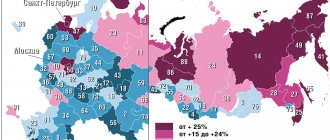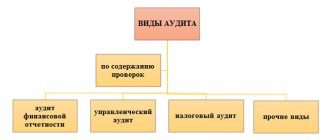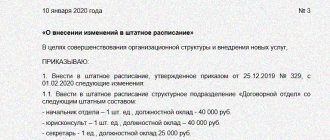Remember!
- IFRS provides management and accounting information for investors and creditors;
- RAS reflects the information necessary to control accounting and preparation of documentation by supervisory authorities.
Table 1
12 differences between RAS and IFRS
| Accounting or reporting principle | International Financial Reporting Standards (IFRS) | Russian Accounting Standards (RAS) |
| 1. Purposes of collecting and systematizing information. | Used by investors and lenders to make investment decisions. | Necessary for providing information to regulatory and tax authorities. |
| 2. Form. | Transactions are reflected primarily from the economic side. The accountant's professional judgment is decisive. | Documentation of transactions prevails over their economic assessment. |
| 3. Currency. | Reporting is prepared in the currency in which the organization receives revenue and makes payments (functional currency). | Reporting can only be prepared in rubles. |
| 4. Financial instruments. | Depending on the nature and expected cash flows, derivative financial instruments are classified as:
Convertible instruments are divided into liabilities and equity. The liability component is accounted for at fair value. “Capital” is accounted for as residual value without the possibility of revaluation. | Derivative financial instruments are not distinguished as a special type of property and are accounted for off-balance sheet accounts. The balance sheet determines the final settlement of transactions with them. There are no general special rules for convertible instruments. They can be either equity (stocks) or liabilities (bonds). |
| 5. Reporting period. | The financial year is not tied to the calendar year. The reporting period can be selected by the company based on the specifics of the work. | The reporting period is set within the calendar year (from January 1 to December 31). |
| 6. Accounting for income and expenses. | Transactions are reflected in compliance with the principle of matching income and expenses. In financial statements, expenses are reported in the statement of comprehensive income. | The principle of matching income and expenses is mentioned in the PBU, but is not always used in practice. |
| 7. Consolidation of reporting. | Income, expenses, property and liabilities are accounted for as one whole due to the fact that reporting is generated for the entire group of interdependent companies: for the parent and subsidiaries together. | Each organization draws up its own balance sheet. The concept of financial statements consolidation in RAS is vague. |
| 8. Determination of the tax base. | Depends on the method of repayment of the book value of assets chosen by the company's management. | The tax base is the amount of income or expense subject to income tax (personal income tax, etc.). |
| 9. Determination of interest income. | The effective interest rate method is used. Its calculation is based on the cash flows that the organization will receive during the contract period. If forecasts change, recalculation is possible. | The interest rate is established by agreement. There is no concept of an effective interest rate. |
| 10. Multi-part agreements. | The multicomponent principle is widely used. | There are no special rules governing multi-part agreements. For each specific transaction, revenue recognition criteria are determined. |
| 11. Fair value of assets. | Often used when estimating the value of assets. The book value of assets cannot be higher than the amount that can be obtained in the current period of time from their sale or use. | Fixed assets in the process of operation are valued at historical cost. The book value of fixed assets and other property is often overstated in the current economic situation. |
| 12. Classification of leases. | Classified by how the risks and rewards of owning the asset are distributed between the lessee and the lessor. | They are classified not as a relationship between the parties to a transaction, but as a form of agreement. |
Pay attention to three main reporting forms:
1) financial results report;
2) cash flow statement;
3) balance.
In IFRS, they are strongly interconnected and are compiled sequentially from 1 to 3. The balance sheet is compiled only on the basis of data from the first two reports. This approach allows you to obtain the most complete information about the financial condition of the company. In RAS, reports are prepared almost independently of each other. And the balance sheet, as a rule, is drawn up first.
Accounting Standards Concepts
The language of accountants is often almost foreign to the average person.
“Balance”, “buldo”, “reversal”, PBU and, finally, even IFRS and RAS. What do all these terms mean and how to use them in practice? To fully understand this, you need to belong to the accounting community. Accountants understand that RAS and IFRS are accounting standards in force in Russia. Concepts such as:
- Russian accounting standards (RAS);
- international financial reporting standards (IFRS);
rarely affect the same company at the same time. Most often, accountants have enough national standards, which the Ministry of Finance proposed to see in the Accounting Regulations (PBU). And who makes IFRS, who makes RAS, is dictated by the rules of doing business.
International standards are necessary only for those organizations that have foreign investments, invest themselves in foreign businesses, are represented in other countries, or sell shares on the Moscow and other stock exchanges. It is important for them to be able to generate financial statements simultaneously according to RAS and IFRS.
IMPORTANT!
The Ministry of Finance has introduced international standards into Russia, but Rosstat and the Federal Tax Service do not accept reporting prepared in accordance with IFRS, and investors, in turn, are unlikely to want to read a financial results report prepared in accordance with RAS standards.
The fact is that the composition and purpose of financial reporting forms under RAS and IFRS differ significantly. Let's figure out why this happens.
Which statements are considered the first statements under IFRS?
An entity's first IFRS financial statements are the first annual statements that adopt IFRS standards through the entity's express and unqualified statement of compliance with IFRSs made in those financial statements.
Reporting can be considered the first one prepared according to IFRS if 5 conditions are met.
- For the most recent prior period, the company presented financial statements in accordance with national requirements, but they did not comply in all respects with IFRS.
- The Company presented its financial statements for the most recent period in accordance with IFRS standards, but did not include an express and unqualified statement of compliance with international standards (or it was a statement of compliance only with certain IFRSs).
- The company prepared financial statements in accordance with IFRS for internal use only and did not present them to external users.
- The IFRS statements have been prepared for consolidation purposes, without preparing a complete set of financial statements that comply with IAS 1 Presentation of Financial Statements.
- The Company has not presented financial statements for prior periods.
A number of actions must be performed in relation to the items of the initial balance sheet:
- recognize all assets and liabilities whose recognition is required by IFRS;
- do not recognize balance sheet items as assets or liabilities if IFRS does not allow this;
- reclassify items that were recognized under previous national accounting rules as liabilities, assets or components of equity of the same type. But which, in accordance with IFRS, relate to another type of asset, liability or component of equity;
- apply IFRS to measure all recognized assets and liabilities.
Please note that the latest version of IFRS 2022 must be applied. An entity may adopt a new international standard that has not yet become mandatory, but only if early adoption is permissible.
Lease classification: comparative analysis of IFRS and RAS
IFRS 16 retains the lease classification only for lessors. They maintain accounting based on the distribution of risks and rewards of ownership of the asset, which are shared between the lessor and the lessee. If a lease transfers to the lessee all the risks and rewards associated with the asset transferred, it is called a finance lease.
According to RAS, lease classification is based on the form of the agreement, and not on the relationship of the parties. The form and content of the leasing agreement are decisive when reflecting the object of the transaction on the balance sheet of the tenant or lessor. As a result, most leases that are accounted for as operating leases under RAS should actually be classified as finance leases under IFRS and accounted for accordingly.
In the case when a legal form is used to reflect a finance lease, users of financial statements cannot correctly assess the financial risks and rewards.
When situations are reported to reflect priority economic content in accordance with international standards, this information will be complete and will make it possible to make rational and well-considered investment decisions. Moreover, the possibility of manipulating financial indicators with the help of contracts that have the legal form necessary for these purposes will disappear.
Balance sheet valuation of assets and liabilities
In RAS, assets and liabilities are valued at historical cost, that is, at the value at which they were placed on the balance sheet. Since their real valuation may change over time, we are talking primarily about assets, reflecting them in the balance sheet at historical cost can lead to a discrepancy between the book value and the real one.
Historical cost is a measure of value used in accounting in which the value of an asset on the balance sheet is recorded at its original cost at the time of acquisition by the company.
In IFRS, there is a concept of fair value, which makes it possible to bring the balance sheet value closer to the real market value.
Fair value is the price that would be received to sell an asset or paid to transfer a liability in an orderly transaction in the principal (or most advantageous) market at the measurement date under current market conditions (that is, the exit price), whether or not the price is directly observable or calculated using another valuation method.
IFRS requires long-lived assets to be tested for impairment.
What is included in the concept of IFRS
IFRS is a set of normative documents (standards and interpretations) that regulate the rules for preparing financial statements by organizations in the commercial sector of the economy. IFRS are not aimed at management, but at users of financial statements, since they need high-quality reporting to make decisions.
IFRS are a set of interrelated documents that include: a preface to the provisions of IFRS; conceptual framework of financial reporting; actually, standards; clarifications of standards or interpretations. They all form a single system and cannot be used separately, however, each document as an element of the system has a specific purpose.
IFRS is developed by the IASB (formerly the IASB Committee), an independent body of the International Financial Reporting Standards Foundation (IFRS), established in 2001. Members of the IASB are responsible for developing and publishing IFRSs, and for approving their interpretations. During the development process, documents for discussion and draft standards are published, on which comments are accepted. The main members of the Council are highly qualified auditors and accountants from different countries.
IFRS ensures the comparability of financial statements between companies on a global scale, and is also a condition for the availability of reporting information for external users, for example, banks, financial funds, investors, business owners from different jurisdictions.
Common reporting standards promote economic efficiency, help investors identify investment opportunities and risks, thereby reducing the cost of attracting investment and improving the process of capital allocation among companies, economic sectors, and geographic regions.
The IASB reports that IFRS is mandatory in 145 countries around the world for all or almost all national companies with public reporting or for financial institutions, in 12 countries companies have the right to apply IFRS on a voluntary basis; IFRS is mandatory for use in 15 G20 member countries.
General form of the IFRS 1 standard
First of all, the standard was created to ensure that the reporting of different companies has the same characteristics. In view of this, anyone who wished to carry out their duties could understand the information from the reports and conduct an analysis.
IFRS 1 provides the most comprehensive and correct presentation of the financial results of an enterprise. These include: the current state of affairs, cash flow, etc. All this is necessary in order to conduct the most clear analysis of the company’s performance.
Balance sheet currency and accounting in Russian enterprises
All of the listed documents, which represent the basics of RAS, also interpret the rules of accounting: financial statements, as well as accounting of property and monetary assets, liabilities, business transactions are carried out in the national currency of the Russian Federation - rubles, and documentation of all business transactions of each company is exclusively in Russian . When partnering with foreign companies, primary documents accepted for accounting must be translated word by word into Russian if they are drawn up in another language.
IFRS 1 reporting
IFRS 1 reporting was created specifically so that it can be applied by all interested parties. His original idea was for it to be the most widely used reporting standard. The result is a complete picture of the enterprise's activities. Since the specifics of companies are different, a set of indicators has been developed that will suit different areas of business.
Specialists, based on ready-made IFRS 1 reporting, can plan, control and propose solutions to increase the efficiency of the company. The work of competitors can be taken as a basis.
Since reporting is based on indicators, they make it easier to achieve your goals.
The indicators may be as follows:
- assets, liabilities and their dynamics after making any important management decisions;
- profit, costs and their changes, depending on external and internal factors;
- contributions and other payments to both owners and shareholders;
- Such financial flows reflect the movement of money within the firm and reflect the performance of all departments.
Analysis of indicators allows management to make timely and correct management decisions that can adjust the business for the better. In addition to general information, you can control the company’s resources and the appropriateness of their use.
Internal and external users of reporting prepared in accordance with RAS
Information from financial statements prepared in accordance with RAS is required:
- internal users - founders, management, owners of company property, to make informed decisions for the further development of the company;
- external users - creditors, investors to analyze the current situation and government agencies, for example, the Federal Tax Service for fiscal purposes, checking compliance with established standards, calculating taxes and fees.
Thus, RAS, the decoding and essence of which are discussed in the publication, are a set of documents that dictate the framework of accounting and the preparation of financial reporting forms.
You can find more complete information on the topic in ConsultantPlus. Free trial access to the system for 2 days.







